
Vegan Kanom Thai
A guide to vegan Thai desserts and snacks in Thailand
Kanom (khanom) Thai, or Thai sweets, are major players in the culinary landscape that is Thai cuisine. In comparison with European sweets, however, kanom Thai might seem daunting. If European confectionary traditions are characterised by pastries and cream, then Thai dessert culture is portrayed on a canvas of sticky rice painted with coconut, starches and fresh tropical fruits.
Often left unexplored by foreigners visiting Thailand, kanom Thai offers a beaming insight into the country's food culture. Thais are inveterate snackers with the same universal fondness for sugar found globally. But Thai sweets are unfamiliar, both in flavour and form, to many Westerners, so here is a list of more than 100 Thai desserts, candies, snacks, and sweets you might find in Thailand.
I hope this guide to Thai desserts is helpful for those wishing the navigate the sweets scene in Thailand, but this list of kanom Thai is nowhere near comprehensive. The list is, however, quite expansive, so I have broken it down into the sections below.
Jump to:
A note on transliterations: this is a murky area, especially for me as a non-linguist. There are a few schools of thought on how Thai language should be written in the English alphabet, but for the sake of people finding my posts I tend to switch between them. For instance kanom and khanom are two variations on the same word based on two schools of transliteration.
Where the kanom may or may not be vegan or is only vegan during certain times of the year, I have added a note. I will continue to update this list as I try and learn of new Thai kanom.
Sticky (Glutinous) Rice Sweets
Mango sticky rice • Khao Niao Mamuang – ข้าวเหนียวมะม่วง
A top favourite snack amongst Thais and foreigners alike, the best time of year to enjoy mango sticky rice is April through June, when the fruits are at their sweetest and juiciest. This rice portion is made by steaming glutinous rice and then finishing its cooking in sweetened coconut milk.
Rainbow Sticky Rice • Khao Niao Mun See Rung – ข้าวเหนียวมูนสีรุ้ง
Also cooked in sweetened coconut milk, this is a more fun and colourful partner to mango (or durian) in the country's famous dessert dish. When coloured naturally, turmeric, butterfly pea, pandan, and black sticky rice, impart shades of yellow, blue, green, and purple, respectively, to the rice. You might also see a dish with 5 colours of sticky rice served with a set of sweet and savoury toppings that are not vegan.
Pandan Sticky Rice • Khao Niao Gaeo Bai Toei – ข้าวเหนียวแก้วใบเตย
Also made by cooking par-steamed glutinous rice with sweet coconut milk, this sticky rice sweet also contains green pandan water (extracted from the leaves of the pandan plant, called bai toei in Thai).
Black sticky rice with sweet coconut • Khao Niao Dam Mun Naa Grachik – ข้าวเหนียวดำมูนหน้ากระฉีก
This is another one made by blending steamed glutinous rice (typically a combination of black and white grains) with sweetened coconut milk. Then you cook shredded coconut with palm or coconut sugar before topping with rice with the caramelised coconut.
Red Sticky Rice Candy • Khao Niao Daeng – ข้าวเหนียวแดง
Caramelised palm sugar mixed with sticky rice and topped with toasted sesame seeds.
Steamed glutinous rice parcels • Khao tom mat – ข้าวต้มมัด
Sweetened glutinous coconut rice wrapped in leaf parcels. The most common will probably contain black beans, but you'll find banana, taro, and other fillings too. Banana leaf is the most common wrapping, but nipa and mangrove fan palm leaves have regional uses.
Grilled sticky rice parcels • Khao Niao Ping ข้าวเหนียวปิ้ง
Popular fillings include banana, black, bean, corn (my favourite) and taro. I've seen durian from time to time.
Sweet glutinous rice in bamboo • Khanom Khao Lam – ข้าวหลาม
The perfect snack for a long bus or train journey, these tubes of sticky rice are made by mixing glutinous rice with coconut, sugar, and salt, and roasted over flame. Beans, taro, and other ingredients are often also mixed in. The gooey bits at the ends are everyone's favourite.
Mixed young green rice • Khao mao kluk - ข้าวเม่าคลุก
Khao mao, or pounded young green rice, can be made from jasmine or glutinous rice. Available for only a few weeks a year, these bright green grains have a slightly yeasty and breadlike aroma. Khao mao kluk is made by mixing the young rice with freshly grated coconut and toasted sesame seeds. If you find it, get it.
Pounded sticky rice with perilla • Khao Nuk Nga – ข้าวหนุกงา
Also called khao buk gna (ข้าวปุกงา) A Lanna (Northern) kanom made by pounding glutinous rice until it is like fluffy mochi, then coating it with perilla seeds.
Kanom Tod (Fried Sweets)
Snow Taro • Puuak Hima – เผือกหิมะ
Taro root cut into chips, fried, and then cooked a second time in a sugar syrup so that it forms a white snowy effect on the surface of the root vegetable. The taro is fried here with pandan leaf for fragrance.
Swan Egg Doughnuts • Kanom Kai Hong – ขนมไข่หงส์
The dough is made from rice and sticky rice flours and the filling is a paste made with mung beans. Much like with the snow taro above, the sugary coating is achieved by cooking the fried doughnuts in sugar syrup until crystalised.
Pig Legs • Khanom Kha Moo – ขนมขาหมู
Despite its non-vegan name, this kanom is made from a mixture of flours and starches that could include rice and/or sticky rice flours, tapioca starch, cornstarch, and wheat flour. This is mixed with ingredients like beans, pumpkin, and sweet potato before being deep fried. These are served with a tamarind dipping sauce.
Deep fried rice cakes with cane sugar• Kanom Nang Let – ขนมนางเล็ด
Popular and with good reason, you will find these fried rice cakes with cane sugar drizzle in various forms throughout the country. In the North they're called khao taen.
Fried young green rice with banana • Kanom Khao Mao Tod – ขนมข้าวเม่าทอด
Young green rice wrapped around banana and deep fried. Any time you can eat khao mao in any form, I recommend you do. As previously mentioned, this is only readily available for a few weeks a year.
Deep Fried Rice Flour Pancake • Kanom Fak Bua – ขนมฝักบัว
Also commonly referred to as kanom dok bua ขนมดอกบัว. Typically white or green (pandan), these deep fried pancakes puff up in the middle and the sugars caramelise around the edges. I have seen some recipes with egg, but have not found this in practice. Other names include juu jun จู้จุน (in Southern dialect) and kanom choke ขนมโช้ก (mostly in Surin province).
Thai rosette fried cookies • Kanom Dok Jok – ขนมดอกจอก
Similar to German rosette cookies, a metal flower shaped mould is dipped in hot oil and then a slightly sweet and salty sesame batter. When the mould is placed back in the hot oil the cookies shake off and fry up. Then they are removed from the oil and placed on a round surface to make them look like blooming flowers.
Candied sweet potato nests • man rang nok – มันรังนก
These are made by cutting sweet potato into matchsticks and deep frying them. After awhile, add a knob of both butter (or margarine) and palm sugar into the oil. When done, strain and quickly form the matchsticks into nests. You will also find taro nests made in the same manner. Because butter could be used, always check.
Battered fried bananas• Gluay Khaek (กล้วยแขก) or Kluay Tod (กล้วยทอด)
Bananas (typically the nam waa variety) dipped in a batter made with rice flour and slaked lime solution and fried, these goodies can stay crispy for hours when fried well. The odd vendor may untraditionally use egg, so best to ask.
Sweet sticky rice noodles • Mee Krop – หมี่กรอบ
Usually not vegan, you can find packets like this sold during the annual vegetarian festival. Thin rice noodles are deep fried and then mixed in a sweet and sour sauce. It lasts for a little while and makes a great gift to bring back home.
Fried sesame balls • Kanom Nga Tod – ขนมงาทอด
Popular in many Asian countries and called jian dui in Chinese, these glutinous rice flour balls are filled with a paste (common fillings are mung bean, red bean, and black sesame among others), rolled in sesame seeds, and fried.
Fried sweet potato balls • Kanom kai nok krata – ขนมไข่นกกระทา
Made with both yellow and purple sweet potatoes, these moreish chewy doughnuts are commonly available street snacks made by making a dough of cooked sweet potato and tapioca starch before deep frying. Want to try it? Here's a recipe.
Tai Yai glutinous rice doughnuts • Khao Mun Kuai – ข้าวมูนข่วย
This Tai Yai (Shan Thai) sweet is made of sticky rice flour rings dipped in sesame seeds, fried slowly on low heat, and then simmered in a sugar cane syrup. Mae Hong Son is a good place to find them. Kanom wong ขนมวง is a more universal version of this sweet, found outside of the North. Kanom he kuay ขนมหีควาย, which translates as "buffalo pussy snack", is another unusual name.
Thai style Chinese crullers • Pa thong ko – ปาท่องโก๋ and khanom see kha ขนมสี่ขา
An ideal accompaniment to congee, pa thong ko is a type of deep fried dough fragrant with ammonia. This may not sound appetising but it is a welcome flavour. The crullers are also eaten with custard, either plain or pandan (not vegan unless indicated otherwise) and with fresh soy milk at breakfast time. Khanom see kha (four legs) is a version local to Phuket that is coated with sugar before frying.
Popped rice and peanut bar • Krayasaat – กระยาสารท
Caramelised palm sugar mixed with sticky rice and tTypically associated with the Autumn Buddhist festival Saat, these bars are made with popped rice (not dissimilar to popcorn), sesame, peanuts, sugar (in this case cane sugar), and coconut milk. Think of them like a Thai granola bar of sorts.opped with toasted sesame seeds.
Fried mochi coated in sugar • Kanom Galorjee – กะลอจี๊
Fried disks made with glutinous rice flour that are then cut up and rolled in a sesame, peanut, and sugar coating.
Kanom Nam Gati (Sweets in coconut milk) and Kanom Chuam (Sweets in Syrup)
Candied Cassava • Man Sampalang Cheum – มันสำปะหลังเชื่อม
This candied cassava syrup, typically eaten with salted coconut cream, is made by simmering cassava in sugar syrup. It's also frequently found at nam kaeng sai (iced sweet stalls) vendors. Here I am eating it with lod chong. Find a recipe for candied cassava here.
Bananas cooked in syrup • Gluay Chuam – กล้วยเชื่อม
Cooked in syrup and served with salted coconut cream like the aforementioned candied cassava, popular varietals used include half ripe egg banana (gluay kai กล้วยไข่) or nam waa bananas. You may also see red bananas in syrup, their colour obtained by from a chemical reaction with hydrolysed lime they are soaking in before cooking.
Other kanom thai chuam ขนมไทยเชื่อม
The same style of cooking in syrup to preserve are used with lots of fruit and vegetables, including (but not limited to):
- Pumpkin (fak tong chuam ฟักทองเชื่อม)
- Unripe papaya (malagor sam rang taen มะละกอสานรังแตน)
- Pomelo skin (pluuak som o chuam เปลือกส้มโอเชื่อม)
- Toddy palm seed (jak tan chuam จากตาลเชื่อม)
- Breadfruit (sa gae chuam สาเกเชื่อม)
Shave ice and iced sweet soups • Nam Kaeng Sai – น้ำแข็งใส
Many of the sweets I mention in this section (including the aforementioned kanom chuam) will be found at a nam kaeng sai business. Vendors have a dozen or more (sometimes many more) toppings to be served with ice. Depending on which items you choose, liquid flavourings may include coconut milk, jasmine sugar syrup, and palm sugar syrup. Most items are vegan, but be aware a herbal beeswax candle (tian op เทียนอบ) is sometimes used for infusing the coconut milk.
Ruby water chestnuts • Tab Tim Grop – ทับทิมกรอบ
Diced water chestnuts are soaked in red dye or syrup, coated with tapioca starch, and boiled to resemble large pomegranate seeds. This is then served with ice, coconut milk, and sugar syrup. The liquid make have been smoked with a beeswax candle or made with jasmine syrup. Young coconut and plain water chestnuts frequently accompany this dessert, which can also be found at nam kaeng sai stalls. It's also great with ripe jackfruit.
Mung bean noodles • Sarim – ซาหริ่ม
Dessert noodles made with mung bean starch, served with coconut milk,, sugar syrup, and ice. Also part of the nam kaeng sai mix.

Sticky rice triangles • Khao Tom Nam Woon – ข้าวต้มน้ำวุ้น
These glutinous rice triangles are made by wrapping and boiling sticky rice in strips of banana leaf. These can be served with nam kaeng sai or with fragrant syrup.
Snake Fruit in Clear Syrup • Sala Loi Gaeo – สละลอยแก้ว
Snake fruit in salted sugar syrup. Loi gaeo style desserts can also be made with other fruits (e.g. santol, marian plum, longdan, rambutan, etc…).
Sugar palm fruit seeds in light syrup • luk chok loi gaeo – ลูกชกลอยแก้ว
You'll find this one in the South, where sugar palm is popular. The flavour is mild, but it's a refreshing treat on a hot afternoon.
Taro dumplings in coconut milk • Bua Loy Puuak – บัวลอยเผือก
Pieces of taro are coated in tapioca starch and boiled. This achieves an effect similar to the tab tim grop above, only soft and not crunchy.
Sticky rice balls in coconut milk • Khao Niao Daeng – ข้าวเหนียวแดง
Sticky rice balls mashed with vegetables like taro and sweet potato, rolled into balls, simmered, and served with warm coconut milk sweetened with palm sugar. This may include a poached egg, so ask. Try my recipe for bua loi if you'd like.
Sweet and salty fish and turtle eggs • Kanom Plaa Grim Kai Dao – ขนมปลากริมไข่เต่า
Yes, the name of this dish translates to plaa grim (a type of fish) and turtle eggs. There are two halves to this dessert, a sweet palm sugar syrup and salty coconut cream. This dish illustrates perfectly how salt and sugar complement each other.
Pandan noodles in coconut milk • Lod Chong – ลอดช่อง
The Thai version of what is called Cendol in Singapore and Malaysia, lod chong is a dessert of short pandan noodles in palm sugar sweetened coconut milk. My favourite lod chong in all Bangkok is dished up by a small stall in Chatuchak market and here is a map link. Here you have an option to have it with black sticky rice, which I recommend.
Pumpkin in coconut milk • Fak Tong Gaeng Buat – ฟักทองแกงบวด
Pumpkin cooked in sugar (usually palm) sweetened coconut milk.
Pandan sago • Sakoo bai toei nam gati – สาคูใบเตยน้ำกะทิ
Sago pearls with pandan, served with salted coconut milk. Sometimes the sago is very firm and cut into squares, or served soupier as in the Chinese style.
Caramelised coconut dumplings in coconut milk • Kanom Ko Nam – ขนมโคน้ำ
Fresh coconut caramelised with palm sugar inside of glutinous rice dumplings. You might also find kanom ko, which is the same dessert but the balls are rolled in freshly grated coconut instead of being served in coconut milk.
Glutinous rice dumplings with mung bean paste • Kanom Hua Lan – ขนมหัวล้าน
Hua lan translates as bald head, although I do not know the origin of this name. These look similar to kanom ko nam but are filled with a sweet mung bean mash.
Pressed dumplings in coconut milk • Krong krang – ครองแครง
Tapioca and rice dumplings affected with a grated paddle to create an almost gnocchi like appearance, krong krang are also served in fresh coconut milk.
Rice flour noodle nests • Kanom Ray Rai – ขนมเรไร
Also called khanom rang rai (ขนมรังไร), these rice flour noodles are made with a special wooden press for making this particular dessert. The noodle bundles are served with shredded coconut, sugar and toasted sesame seeds, and fresh salted coconut cream.
Kanom Nung (Steamed Sweets) and Kanom Tom (Boiled Sweets)
Coconut and pumpkin puddings • Kanom Tuai ขนมถ้วย and kanom fak tong ขนมฟักทอง
Kanom tuai can be made with different flavours (e.g. pandan). The white sweet here is with coconut milk (kanom tuai gati ขนมถ้วยกะทิ). The yellow sweet is khanom fak tong, which is made with pumpkin. These are made by steaming batter in small bowls.
Steamed banana pudding • Kanom Kluay – ขนมกล้วย
Steamed banana pudding cups, made similarly to the kanom tuai above. There is a recipe for kanom kluay here
Toddy palm cake • Kanom tan – ขนมตาล
Made from the fruit of the same palm that produces palm sugar. The batter was traditionally left to ferment slightly to let natural yeasts develop so it would rise naturally, but nowadays many people use leavening agents to speed up the process.
Bao with custard filling • Salapao sai sang ka yaa – ซาลาเปาไส้สังขยา
The custard in question here is pandan flavoured. This was bought in Phuket during the vegetarian festival, so was vegan. This custard would often contain animal products otherwise, so ask if in doubt.
Steamed stuffed sticky rice custard parcels • Kanom Sai Sai – ขนมใส่ไส้
Also known as kanom sot sai (ขนมสอดไส้). Caramelised balls of palm sugar shredded coconut inside of sticky rice dough inside of salted coconut cream.
Pyramid shaped dumplings • kanom tian – ขนมเทียน
This, the world's worst photo, shows both types of this thai sweet. On the left is kanom tian sai kem (ขนมเทียนไส้เค็ม), a dumpling steamed in banana leaf that's filled with a savoury mung bean paste. On the right is kanom tian sai waan (ขนมเทียนไส้หวาน), which contains a sweet coconut filling.
Mouse poo candy • Khao Niao Daeng – Kanom Kee Noo – ขนมขี้หนู
Yes, the literal translation of kee noo is mouse droppings. Steamed jasmine infused sweet rice flour crumbles served with fresh coconut.
Steamed sticky layer cake • Kanom Chan – ขนมชั้น
Beautiful and fun to eat, kanom chan is made by steaming individual layers of batter made with various starches (depending on desired consistency).
Brown sugar cakes • Kanom Gorsui – ขนมโกสุ้ย
This is a speciality of Phuket. Steamed rice flour treats made with brown sugar, then topped with salted coconut.
Steamed jasmine cakes • Khanom nam dok mai – ขนมน้ำดอกไม้
Steamed rice flour treats made with jasmine scented water. These are steamed in small cups and the indentation forms as they steam.
Rice cakes with savoury topping • Giam Goi (เกี่ยมโก้ย) / Kanom Tuai Kem (ขนมถ้วยเค็ม)
Made in the same way as the kanom dok mai above, this is more savoury than sweet. This isn't uncommon with kanom, which is more an indication of a snack than a sweet. Giam goi are steamed rice flour cakes with various toppings. Often they are not vegan, so look out for these at vegan businesses and during the vegetarian festival. The toppings here are fried shallots with a sweet, sour, salty, and spicy sauce.
Steamed cupcakes • Kanom Pui Fai – ขนมปุยฝ้าย
Also called fa gao (Chinese), these colourful steamed cupcakes often contain animal ingredients. Again, look for them at vegan establishments or during the vegetarian festival.
Steamed cassava cakes • Kanom Man Sampalang – ขนมมันสำปะหลัง
Made by steaming grated cassava (tapioca) with coconut milk, flour, and sugar. They can be steamed in cups or trays (and then cut into squares, seen here). After they're cut they're rolled in coconut.
Sweet & savoury cake with mung bean • Khanom Keng Sai Kem – ขนมเข่งไส้เค็ม
The yellow dot in the middle is a sweet-savoury mashed mung bean mixture with coriander root, white pepper, salt, and sugar. Surrounding this is a mixture made from sticky rice flour, sugar, and water (the Thai version of nian gao)
Dumplings with candied coconut • Kanom Ko – ขนมโก๋
Palm sugar caramelised coconut wrapped in sticky rice dough, boiled, and rolled in salted coconut.
Lady fingers with grated coconut• Kanom Leb Meu Nang – ขนมเล็บมือนาง
Rice flour dumplings rolled in freshly grated coconut, served with sesame seeds, sugar, and salted coconut milk.
Sticky rice dumpling with mung beans • Kanom tua paep – ขนมถั่วแปบ
Dough made with sticky rice is flattened into a disk, boiled, and then rolled in/stuffed with a coconut and mung bean mixture. This is served with sugar and sesame seeds on top.
Kanom Guan (Stirred Sweets)
Pandan and charcoal pudding • Kanom Piak Boon – ขนมเปียกปูน
Hello, I am the first person in the room to call bullshit on the health claims about charcoal, but these are delicious. The alkalinity of hydrolysed lime imparts an eggy flavour and the coconut husk charcoal is used for the black version gives a pleasant gritty texture. The green is made with pandan.
Alkaline sweets • Kanom Gee Gooi – ขนมกีโก้ย
Also called Tee Nya Kuih (Malay), this sweet is yellow from the addition of alkaline water (lye) and dye, which also imparts an eggy flavour. It is served with a brown sugar syrup. The word gee goi is from the original Hokkien dialect. This sweet is local to Phuket and is uncommon.
Coconut icing topped pudding • Ta Ko – ตะโก้
This favourite can come in many forms, with the most well known perhaps being tapioca with corn. Taro (pictured), sweet potato, pumpkin, and other ingredients can also feature. Ta ko are topped with rich coconut cream.
Sticky rice caramel taffy • Kalamae – กะละแม / กาละแม
Glutinous rice flour, palm sugar, and coconut milk are stirred together until cooked down into a taffy like consistency. Kalamae comes in different fruit flavours.
Thai mung bean marzipan • Look Chub – ลูกชุบ
Made with mung beans instead of almonds, these sweets are shaped into fruits and vegetables much like marzipan. Formerly enjoyed only by the royal family, luk chup is now available on the streets. It can be coated with with agar or gelatin.
Agar Jelly with lemon basil seeds • Wun Met Manglak – วุ้นเม็ดแมงลัก
Think of lemon basil seeds as the chia of Thailand. They don't impart any flavour, but the texture is nice.
Coconut Agar • Kanom Wun Gati – วุ้นกะทิ
While this is typically made with agar, I have seen some recipes using gelatin, but it'll almost always be made with agar as this is traditional.
Dried wheat flour sugar candy • Kanom Alua – ขนมอาลัว
This kanom is made with wheat flour, coconut milk, sugar, and food colouring. The mix is cooked until thickened and then piped into shapes. Finally these are left to sun dry for a few days to obtain a crispy outer shell.
Candied coconut shreds • Maprao Gaew – มะพร้าวแก้ว
Shredded coconut is stirred in coconut sugar until crystalised slightly. Then it's shaped and left to dry.
Griddled and Grilled Sweets
Thai coconut griddle cake • Khanom Baa Bin – ขนมบ้าบิ่น
Khanom baa bin is often sold in this round shape, but this coconut sweet also comes in other forms. Sometimes it is made by baking, or a combination of stovetop and baking methods. You can try my recipe for kanom baa bin here. The variation that is square and baked may or may not contain eggs.
Grilled bananas and cassava • Gluay Ping (กล้วยปิ้ง) and Man Yang (มันย่าง)
Banana and cassava are slow grilled and then served with a warm coconut syrup. These are easily found in Bangkok's Chinatown. The syrup may or may not contain butter, so always check first.
Sticky coconut in nipa palm • Kanom jaak – ขนมจาก
Shredded coconut, sticky rice flour, and palm sugar are wrapped in nipa palm leaves and grilled. The leaf, in combination with cooking process, imparts a smoky pine-like aroma.
Roti – โรตี
Roti in Thailand are typically not vegan because of use of butter or ghee, and the addition of condensed milk. During the vegetarian festival, however, you might be lucky enough to find someone making a vegan version. The condensed milk pictured is no longer in production, and it's extremely common to find dairy condensed milk at the festival, so always check first.
Pakistani Style Roti •roti Pakistan – โรตีปากีสถาน
While the roti above was thin, large, and rolled, these are Pakistani roti found in Hat Yai during the vegetarian festival. I had mine drenched in vegan condensed milk. This type of roti is also great with massuman curry. Again, always check items like this don't contain dairy (even if they are labelled jay เจ)
Grilled sesame rice crackers • Khao Kriap Nga – ข้าวเกรียบงา
These disks are made with palm sugar, coconut, flour, and sesame seed. They are cooked and dried, and then grilled until crispy.
Chinese sweetmeat pastry • Sao Ping – เซาปิ่ง
Various fillings such as black bean, red bean, taro, and more are wrapped in a dough that is moulded in a ring and fried. Also called kanom pia tod (ขนมเปี๊ยะทอด). Ask if the dough contains egg.
Thai dorayaki • Kanom Tokyo – ขนมโตเกียว
Pancakes with custard filling that may or may not be vegan. During the vegetarian festival you are more likely to find a vegan version. Sausages or pork may also be inside. The more common shape than what's pictured is an oblong pancake rolled up around filling in a tube shape.
Grilled cassava balls • Mun Ping – มันปิง
Steamed cassava, coconut cream, and sugar are mashed together, formed into balls, and grilled over a low heat. These contain corn too.
Dice cakes • Kanom Luk Tao – ขนมลูกเต๋า
Luk tao means dice, a description based on the cubed shape of this kanom. There are many fillings (e.g. mung bean, sweet potato, etc…), but black sesame is my favourite. The dough may contain egg so ask.
Poor man's pancake • Kanom Taeng Taek – ขนมถังแตก
Thick rice flour and coconut milk pancakes folded with various fillings like fresh coconut and sugar, corn, and more. Custard fillings are typically not vegan unless specified during the vegetarian festival. The batter may also contain egg outside of this scenario.
Thai coconut half globe pancakes • Kanom Krok – ขนมครก
The famous Thai pancakes everyone goes mad for in Thailand, these are made with rice flour, jasmine rice, and coconut milk. Toppings range from sweetcorn to spring onion, with many items in between (gingko, taro, sweet potato, and more).
Tapioca starch pancakes • Kanom Krok Singapore / kanom krok bai toie – ขนมครกสิงคโปร์ / ขนมครกใบเตย
Named after "Singapore flour," the old Thai name for tapioca starch, this style of kanom krok is cooked in a flower shaped pan similar to the takoyaki style pan used for regular kanom krok. This style of kanom krok may or may not contain eggs, so always ask first.
Thai crispy pancake tacos • Kanom Buang – ขนมเบื้อง
Based on an ancient dessert, khanom buang are typically non-vegan. Egg is often used in the batter and the filling often contains egg based ingredients like meringue. During Teetsagon Kin Jay, however, you might be lucky enough to find vendors making vegan versions with coconut fillings.
Misc Thai Sweets and Snacks
Thai candy floss in roti • Roti Sai Mai – โรตีสายไหม
Especially famous in Ayutthaya, this hand pulled candy floss (not spun, as many references state) is wrapped in a thin roti and eaten like a burrito.
Black Grass jelly • Chao Guuai – เฉาก๊วย
Chao kuai is made with the Chinese mesona plant, which is left to oxidise in the sun. The dried plants are then boiled with an alkaline liquid and mixed with a starch to solidify into a jelly. In Thailand chao kuai is often served with brown sugar, but can be found at nam kaeng sai (iced dessert soup) stalls as well.
Pounded peanut brittle • Kanom Tup Tap – ขนมตุ๊บตั๊บ
Tup tap is the onomatopoeic word signifying the sound made while making this kanom. Warm peanut taffy is pounded with wooden mallets before it is flattened, sprinkled with more peanuts, and rolled. The tubes are then cut and sold. The texture is flaky and crunchy.
Dragon's beard candy • Kanom Mai Faa – ขนมไหมฟ้า
This Chinese peanut filled sweet is wrapped in hand pulled cotton candy made with maltose syrup and sugar. It's effectively kanom tup tap with an additional outer layer. Sometimes vendors will say it's honey. I don't know if it's literally honey or not, so best to ask.
Cake with agar based icing • cake naa nim – เค้กหน้านิ่ม
Naa nim style cakes are common in Thailand, though you'll need to find a vegan restaurant such as May Veggie Home in Bangkok to get a vegan version. The cake itself is a fairly standard cake by Western values, with a unique icing set with a small amount of agar. Chocolate and orange are common.
Soft bread • Kanom Pang – ขนมปัง
Often not vegan, kanom pang involves soft white bread smeared with margarine and sugar or other sweet stuff. It's a favourite snack in Thailand. Look for them during the vegetarian festival for vegan versions, but be careful there's no dairy because milk is of little concern to some vendors during the festival.
7-11 custard breads • Packaged Kanom Pang – ขนมปัง
Worthy of its own mention are kanom pang you can purchase at convenience stores like 7-11 and Family Mart during Teetsagan Kin Jay. These are filled with coconut taro and coconut pandan custards.
Corn + coconut • Khao Pote Kluk Maprao – ข้าวโพดคลุกมะ
Caramelised palm sugar mixed with sticky rice and topped with toasted sesame seeds.
Candy floss / cotton candy / fairy floss • Sai Mai – สายไหม
Your standard candy floss, but with some tropical twists. For instance, banana, lychee, coconut…
Phulae pineapple • Khao Niao Daeng – Sapparot Phulae – สับปะรดภูแล
These apple sized mini pineapples are like pineapples amplified. Very sweet and acidic.
Fruit with salt-sugar- chilli seasoning • Prik glua jim ponlamai – พริกเกลือจิ้มผลไม้
While not a specific dessert on its own, it isn't unusual to dip fruits in various seasonings. One is prik glua, which is made from sugar, salt, and fresh chilies. Others include shrimp and fish sauce, so be aware of this.


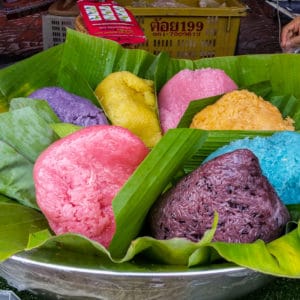

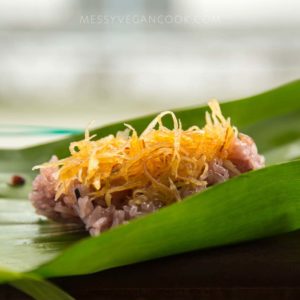












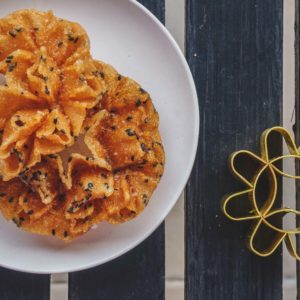



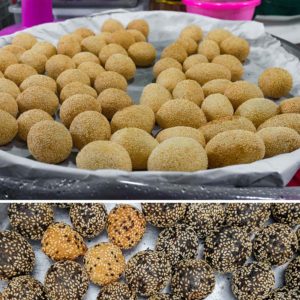



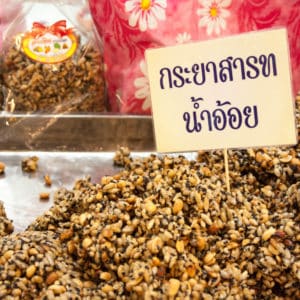




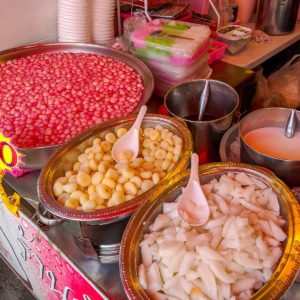







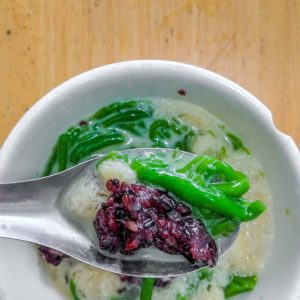
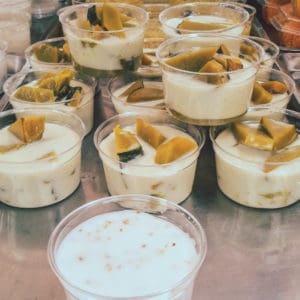



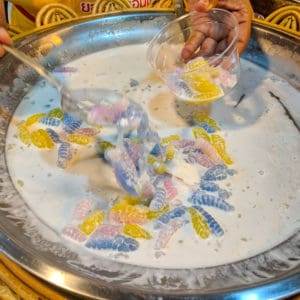

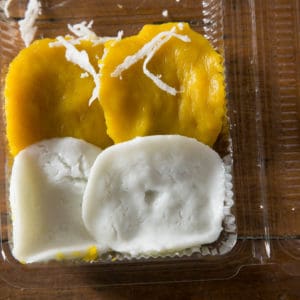



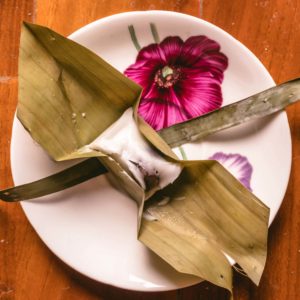




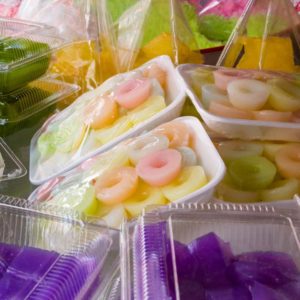









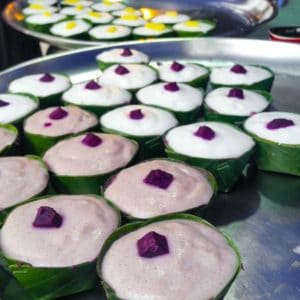
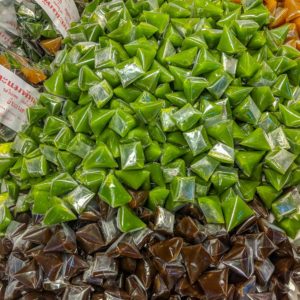
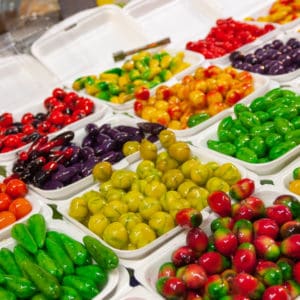

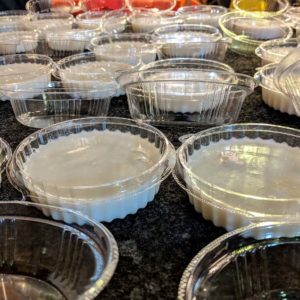



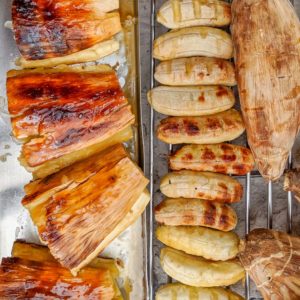
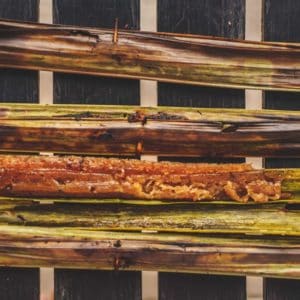

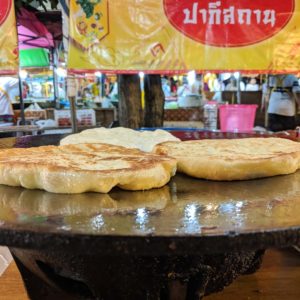


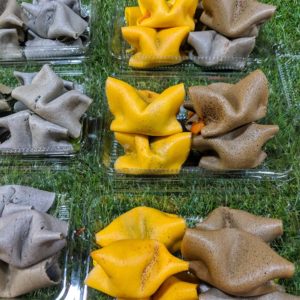


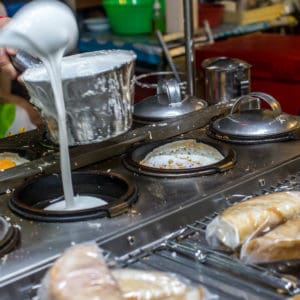


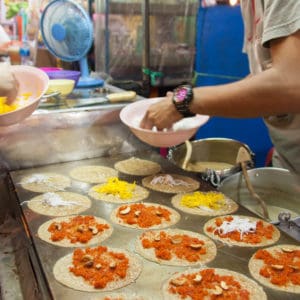


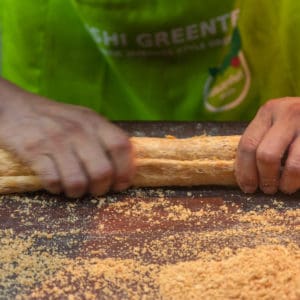


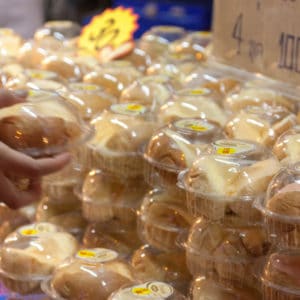

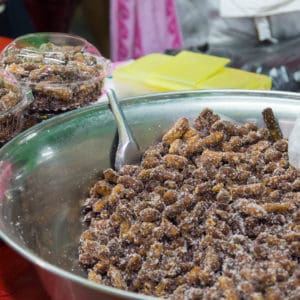

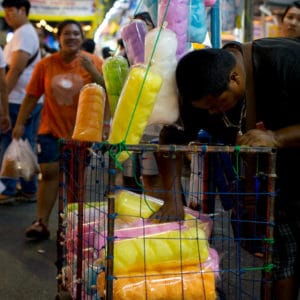
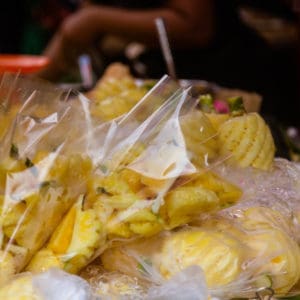





Leave a Reply